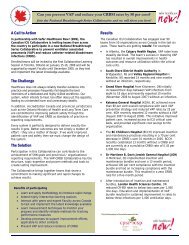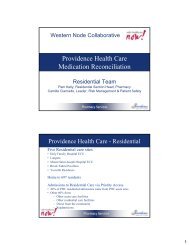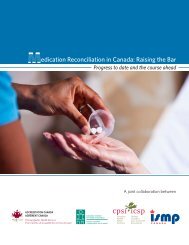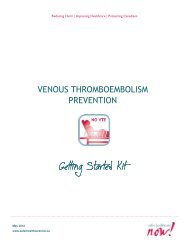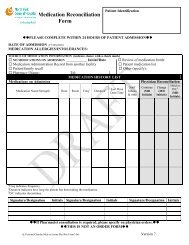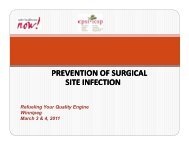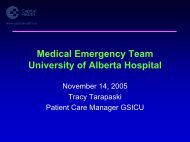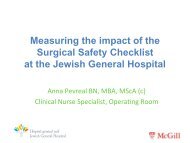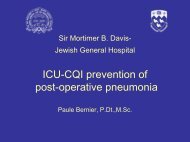VAP Getting Started Kit - Safer Healthcare Now!
VAP Getting Started Kit - Safer Healthcare Now!
VAP Getting Started Kit - Safer Healthcare Now!
You also want an ePaper? Increase the reach of your titles
YUMPU automatically turns print PDFs into web optimized ePapers that Google loves.
<strong>Safer</strong> <strong>Healthcare</strong> <strong>Now</strong>! Prevent Ventilator Associated Pneumonia <strong>Getting</strong> <strong>Started</strong> <strong>Kit</strong><br />
Some people use sedation scales to manage over sedation. Is this a reasonable<br />
substitute for the interruption of sedation in the bundle?<br />
The use of subjective and objective criteria may be helpful in maintaining the desired level of<br />
sedation, despite changes in medical personnel and sedation goals. Although no true reference<br />
measure or criterion exists for sedation assessment, several subjective patient assessment<br />
scoring systems have been developed, including the following:<br />
• Motor Activity Assessment Scale (MAAS) 172<br />
• The Sedation-Agitation Scale (SAS) 173<br />
• The Richmond Agitation-Sedation Scale (RASS) 174<br />
However, these scales are not substitutes for the standard of interruption of sedation. In the<br />
Kress trial, patients were in fact subjected to both a sedation scale and interruption of sedation.<br />
Should I include patients with tracheotomies in the ventilator bundle?<br />
The ventilator bundle has primarily been tested on intubated patients, rather than those with<br />
tracheotomies, so we do not have specific evidence to adequately tell you the effect of the<br />
current <strong>VAP</strong> bundle on this population. Some bundle components are not applicable such as the<br />
presence of a CASS-ETtube. These patients may still however benefit from the other <strong>VAP</strong> bundle<br />
components.<br />
If a patient is admitted to the ICU without a CASS-ETT, what do we do?<br />
The decision to change a regular ETT to a CASS-ETT must take into consideration the patient<br />
specific risks associated with the change of such a tube (loss of airway, regurgitation and<br />
aspiration, cardiopulmonary arrest, etc.). Specifically, one must balance the fact that we know<br />
that re-intubated patients have a higher risk of <strong>VAP</strong> 175 against the protective effects of an initial<br />
CASS-ETT intubation. We do not have specific evidence about the risk-benefit ratio of electively<br />
re-intubating an ICU patient with a CASS-ETT.<br />
I would like to implement the use of CASS-ETT, but I am concerned about reports of<br />
tracheal injury.<br />
It is the Faculty’s opinion that the weight of current evidence favours the use of the CASS-<br />
ETTube. In 2004, an in vivo study on sheep documented tracheal mucosal injury at the level of<br />
the subglottic suction orifice, along with heavy tracheal bacterial colonization when in the sheep<br />
that were maintained “head-up”. 91 During that study, the sheep were in the prone position with<br />
the head remaining midline and posterior neck flexed. This position alters the normal curvature<br />
of the ET tube and places the subglottic suction orifice in the upper subglottic region.<br />
Extrapolation of these findings to humans may be limited, in as much as only one small case<br />
series reported such injury in two of five patients with the Hi-Lo Evac, developing laryngeal<br />
edema immediately after extubation and requiring reintubation. 176 Whether the CASS-ETT<br />
contributed to laryngeal edema alone is not known. Standard ET tubes are known to be<br />
associated with tracheal trauma because they do not conform to the patient’s anatomy resulting<br />
in pressure on soft tissue. ET tube suctioning and suction catheters have been known to cause<br />
mucosal injury by denuding the tracheal mucosa at the site where the suction catheter lumen<br />
contacts the tracheal tissue during suction application. The potential for a CASSETT to cause<br />
similar mucosal injury is not known. However, Valles reported no increase in post-extubation<br />
June 2012 44



